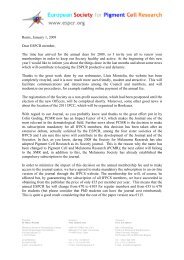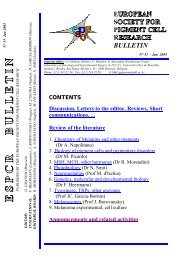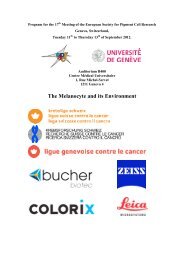espcrbulletin - European Society for Pigment Cell Research
espcrbulletin - European Society for Pigment Cell Research
espcrbulletin - European Society for Pigment Cell Research
You also want an ePaper? Increase the reach of your titles
YUMPU automatically turns print PDFs into web optimized ePapers that Google loves.
tyrosinase and dopamine-beta-hydroxylase. Iron is similarly required in numerous essential<br />
proteins, such as the heme-containing proteins, electron transport chain and microsomal electron<br />
transport proteins, and iron-sulfur proteins and enzymes such as ribonucleotide reductase, prolyl<br />
hydroxylase phenylalanine hydroxylase, tyrosine hydroxylase and aconitase. The essentiality of<br />
iron and copper resides in their capacity to participate in one-electron exchange reactions.<br />
However, the same property that makes them essential also generates free radicals that can be<br />
seriously deleterious to cells. Thus, these seemingly paradoxical properties of iron and copper<br />
demand a concerted regulation of cellular copper and iron levels. Here we review the most salient<br />
characteristics of their homeostasis.<br />
- Chaki M, Mukhopadhyay A, Chatterjee S, Das M, Samanta S, Ray K.<br />
Higher prevalence of OCA1 in an ethnic group of eastern India is due to a founder mutation<br />
in the tyrosinase gene. Mol Vis. 11:531-4, 2005.<br />
PURPOSE: Oculocutaneous albinism (OCA) is a group of autosomal recessive disorders<br />
characterized by deficient synthesis of melanin pigment and associated with common<br />
developmental abnormalities of the eye. It is one of the major causes of childhood blindness in<br />
India. The disease is common among an ethnic group (Tili) of Eastern India, which represents<br />
about 12.56% of the Bankura district population (approximately 0.4 million) of West Bengal. The<br />
purpose of the study was to investigate the molecular lesions causing OCA within this ethnic group<br />
<strong>for</strong> the unequivocal diagnosis of the carriers and attempt to decipher the cause <strong>for</strong> the high<br />
prevalence of OCA. METHODS: Fourteen OCA-affected Tili families consisting a total of 161<br />
individuals, including 26 patients, were recruited <strong>for</strong> the study. A lack of tyrosinase (TYR) activity<br />
among all the patients was ascertained by the tyrosinase hair bulb assay. Mutation screening in the<br />
tyrosinase gene (TYR) was done by single strand con<strong>for</strong>mational polymorphism (SSCP) and DNA<br />
sequencing. The restriction fragment length polymorphism (RFLP) assay was carried out to<br />
determine the frequency of the pathogenic changes among the normal individuals. Haplotype<br />
analysis was per<strong>for</strong>med at the TYR locus using a set of in<strong>for</strong>mative microsatellite and SNP<br />
markers. RESULTS: All the patients were homozygous <strong>for</strong> a null mutation (c.832C>T,<br />
Arg278stop) in TYR exon 2, which might cause a complete loss of enzyme activity. The mutation<br />
occurred in the same haplotype background. The frequency of the disease in this ethnic group was<br />
estimated to be significantly higher than the world average. CONCLUSIONS: OCA1 in the Tili<br />
population is due to the occurrence of a founder mutation in the TYR as indicated by haplotype<br />
analysis. Higher prevalence of the mutation in the population group is due to marriage within the<br />
same community. The diagnostic RFLP assay can be utilizad <strong>for</strong> genetic counseling and thereby<br />
will help to reduce the disease load on the population.<br />
- Chang TS, Ding HY, Lin HC.<br />
Identifying 6,7,4'-trihydroxyisoflavone as a potent tyrosinase inhibitor. Biosci Biotechnol<br />
Biochem. 69(10):1999-2001, 2005.<br />
A known biotrans<strong>for</strong>med compound, 6,7,4'-trihydroxyisoflavone, was identified as a potent<br />
tyrosinase inhibitor. It inhibited mushroom tyrosinase with an IC(50) value of 9.2 muM, which is<br />
six times the anti-tyrosinase activity of kojic acid (IC(50)=54.4 muM). The inhibition kinetics,<br />
analyzed by Lineweaver-Burk plots, indicated 6,7,4'-trihydroxyisoflavone to be a competitive<br />
inhibitor of tyrosinase when L-tyrosine was used as a substrate. Its biosynthesis precursors and<br />
analogs, including glycitein, daidzein, and genistein, showed little anti-tyrosinase activity. The<br />
results suggest that hydroxyl groups at the C-6 and C-7 positions of the isoflavone skeleton might<br />
play an important role in the expression of tyrosinase inhibitory activity.<br />
- Choi H, Ahn S, Lee BG, Chang I, Hwang JS.<br />
Inhibition of skin pigmentation by an extract of Lepidium apetalum and its possible<br />
implication in IL-6 mediated signaling. <strong>Pigment</strong> <strong>Cell</strong> Res. 18(6):439-46, 2005.<br />
1437







